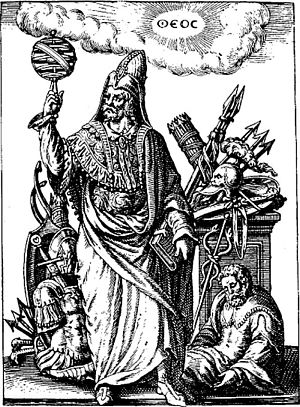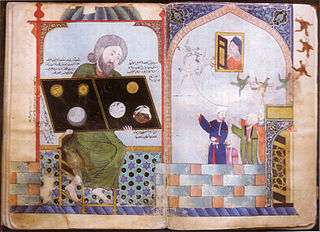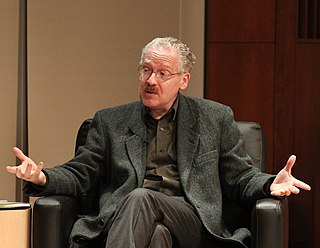Related Research Articles

Alchemy is an ancient branch of natural philosophy, a philosophical and protoscientific tradition that was historically practised in China, India, the Muslim world, and Europe. In its Western form, alchemy is first attested in a number of pseudepigraphical texts written in Greco-Roman Egypt during the first few centuries AD.
Chemistry is the scientific study of the properties and behavior of matter. It is a physical science within the natural sciences that studies the chemical elements that make up matter and compounds made of atoms, molecules and ions: their composition, structure, properties, behavior and the changes they undergo during reactions with other substances. Chemistry also addresses the nature of chemical bonds in chemical compounds.

Abū Mūsā Jābir ibn Ḥayyān, died c. 806−816, is the purported author of an enormous number and variety of works in Arabic, often called the Jabirian corpus. The works that survive today mainly deal with alchemy and chemistry, magic, and Shi'ite religious philosophy. However, the original scope of the corpus was vast and diverse, covering a wide range of topics ranging from cosmology, astronomy and astrology, over medicine, pharmacology, zoology and botany, to metaphysics, logic, and grammar.

Hermes Trismegistus is a legendary Hellenistic period figure that originated as a syncretic combination of the Greek god Hermes and the Egyptian god Thoth. He is the purported author of the Hermetica, a widely diverse series of ancient and medieval pseudepigraphica that lay the basis of various philosophical systems known as Hermeticism.

Abū Bakr al-Rāzī, c. 864 or 865–925 or 935 CE, often known as (al-)Razi or by his Latin name Rhazes, also rendered Rhasis, was a Persian physician, philosopher and alchemist who lived during the Islamic Golden Age. He is widely regarded as one of the most important figures in the history of medicine, and also wrote on logic, astronomy and grammar. He is also known for his criticism of religion, especially with regard to the concepts of prophethood and revelation. However, the religio-philosophical aspects of his thought, which also included a belief in five "eternal principles", are fragmentary and only reported by authors who were often hostile to him.
The compound hydrogen chloride has the chemical formula HCl and as such is a hydrogen halide. At room temperature, it is a colorless gas, which forms white fumes of hydrochloric acid upon contact with atmospheric water vapor. Hydrogen chloride gas and hydrochloric acid are important in technology and industry. Hydrochloric acid, the aqueous solution of hydrogen chloride, is also commonly given the formula HCl.

Mercury(II) chloride (or mercury bichloride, mercury dichloride), historically also known as sulema or corrosive sublimate, is the inorganic chemical compound of mercury and chlorine with the formula HgCl2, used as a laboratory reagent. It is a white crystalline solid and a molecular compound that is very toxic to humans. Once used as a treatment for syphilis, it is no longer used for medicinal purposes because of mercury toxicity and the availability of superior treatments.
The Emerald Tablet, the Smaragdine Table, or the Tabula Smaragdina is a compact and cryptic Hermetic text. It was a highly regarded foundational text for many Islamic and European alchemists. Though attributed to the legendary Hellenistic figure Hermes Trismegistus, the text of the Emerald Tablet first appears in a number of early medieval Arabic sources, the oldest of which dates to the late eighth or early ninth century. It was translated into Latin several times in the twelfth and thirteenth centuries. Numerous interpretations and commentaries followed.
Wladimir Alekseevich Ivanow was a Russian orientalist. He was born in Saint Petersburg, Russia and died in Tehran, Iran. He was a scholar of Islam, with a particular focus on Ismailism. He graduated in 1907 and joined the faculty of Oriental Languages of the University of St. Petersburg.

The Aurora consurgens is an alchemical treatise of the 15th century famous for the rich illuminations that accompany it in some manuscripts. While in the last century, the text has been more commonly referred to as "Pseudo-Aquinas", there are as well arguments in favour of Thomas Aquinas, to whom it has originally been attributed in some manuscripts. The translated title from Latin into English is "Rising dawn."

Zosimos of Panopolis was a Greek alchemist and Gnostic mystic who lived at the end of the 3rd and beginning of the 4th century AD. He was born in Panopolis, and flourished ca. 300. He wrote the oldest known books on alchemy, which he called "Cheirokmeta," using the Greek word for "things made by hand." Pieces of this work survive in the original Greek language and in translations into Syriac or Arabic. He is one of about 40 authors represented in a compendium of alchemical writings that was probably put together in Constantinople in the 7th or 8th century AD, copies of which exist in manuscripts in Venice and Paris. Stephen of Alexandria is another.
The word chemistry derives from the word alchemy, which is found in various forms in European languages.

Muḥammad ibn Umayl al-Tamīmī, known in Latin as Senior Zadith, was an early Muslim alchemist who lived from c. 900 to c. 960 AD.

This timeline of chemistry lists important works, discoveries, ideas, inventions, and experiments that significantly changed humanity's understanding of the modern science known as chemistry, defined as the scientific study of the composition of matter and of its interactions.

Nuruddin Sikandar Shah was the Sultan of Bengal in 1481 CE for a brief number of days.

Alchemy in the medieval Islamic world refers to both traditional alchemy and early practical chemistry by Muslim scholars in the medieval Islamic world. The word alchemy was derived from the Arabic word كيمياء or kīmiyāʾ and may ultimately derive from the ancient Egyptian word kemi, meaning black.

Idris is an ancient prophet mentioned in the Quran, who Muslims believe was the third prophet after Seth. He is the second prophet mentioned in the Quran. Islamic tradition has unanimously identified Idris with the biblical Enoch. Many Muslim scholars of the classical and medieval periods held that Idris and Hermes Trismegistus were the same person.

Lawrence M. Principe is the Drew Professor of the Humanities at Johns Hopkins University in the Department of History of Science and Technology and the Department of Chemistry. He is also currently the Director of the Charles Singleton Center for the Study of Premodern Europe, an interdisciplinary center for research at Johns Hopkins. He is the first recipient of the Francis Bacon Medal for significant contributions to the history of science. Principe's research has been supported by the National Science Foundation, the National Endowment for the Humanities, the American Philosophical Society, the Chemical Heritage Foundation, and a 2015-2016 Guggenheim Fellowship. Principe is recognized as one of the foremost experts in the history of alchemy.
William Arthur Smeaton was a British chemist and historian of science, who wrote more than seventy-five articles and several books on the history of chemistry in France in the 18th and 19th centuries.

Nūr Qut̤b ʿĀlam was a 14th-century Bengali Islamic scholar, author and poet. Based in the erstwhile Bengali capital Hazrat Pandua, he was the son and successor of Alaul Haq, a senior scholar of the Bengal Sultanate. He is noted for his efforts in preserving the Muslim rule of Bengal against Raja Ganesha and pioneering the Dobhashi tradition of Bengali literature.
References
- ↑ F.H.C. Butler. “Obituary: Henry Ernest Stapleton. 1878-1962.” The British Journal for the History of Science, vol. 2, no. 1, 1964, pp. 64–67. http://www.jstor.org/stable/4025085. Accessed 7 Jun. 2022.
- ↑ Sutapa Sinha, 2010. The Coin Collection of the Bengal Sultans in the Cabinet of Heberden Coin Room, Ashmolean Museum, Oxford, in Bishnupriya Basak (ed.) Pratna Samiksha: A Journal of Archaeology, New Series, 1: 163-175. Kolkata. Sutapa Sinha, 2017. Coin Hoards of the Bengal Sultans: 1205-1576 AD from West Bengal, Bihar, Jharkhand, Assam and Bangladesh. Gurgaon.
- ↑ Stapleton, H.E.; Husain, M. Hidayat (1933). Three Arabic Treatises on Alchemy by Muhammad bin Umail (10th Century A.D.). India: Asiatic Society of Bengal. p. 222.